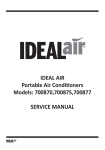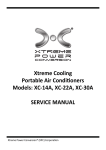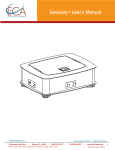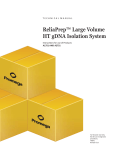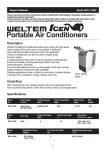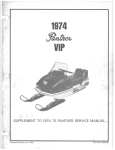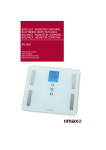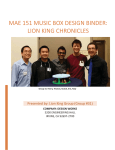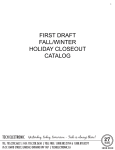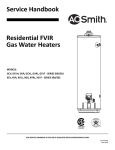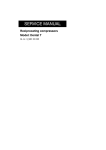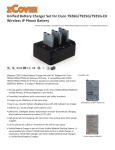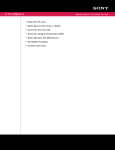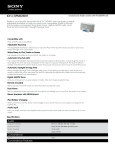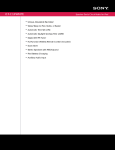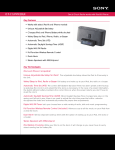Download 700881 SERVICE MANUAL
Transcript
IDEAL AIR
Portable Air CondiƟoners
Model: 700881
SERVICE MANUAL
page 1
Service Manual
700881
Table of Contents
GENERAL DESCRIPTION..................................................................................4
General air condi oning system
Portable air condi oning system
SPECIFICATIONS..............................................................................................5
Exterior Dimension Diagram
Technical Specifica ons
Characteris cs
CONSTRUCTION.............................................................................................7
Internal Structure
REFRIGERANT SYSTEM CONSTRUCTION.........................................................8
Compressor
Compressor lubrica on
Condenser
Capillary Tube
Evaporator
Accumulator
ELECTRICAL SYSTEM.....................................................................................13
Circuit Diagram
Control panel
Program Se ng
Controller Board
Control Specifica ons
Self-Diagnos c Codes
Compressor
Evaporator Fan Motor
Condenser Fan Motor
Capacitor
Molded Case Circuit Breaker
Magne c Contact
Thermal Relay
Temperature Thermistor
Drain Tank Switch
2 page
700881
Service Manual
ASSEMBLY.....................................................................................................26
Component parts
General Safety Informa on
Troubleshoo ng chart
DISASSEMBLY................................................................................................30
Disassembly
Control panel removal
Electrical parts and relay board removal
Fan motor removal
REFRGERANT SYSTEM REPAIR.......................................................................37
Brazing
Removal of Refrigerant System Components
Charging the System with R-410A Refrigerant
Refrigerant Charging Work
page 3
700881
Service Manual
GENERAL DESCRIPTION
General air condiƟoning system
1) conven onal air condi oners cool the en re enclosed environment.
2) They act as “heat exchangers”, equiring an interior unit (evaporator) to blow cool
air into the interior and an exterior unit (condenser) to exhaust exchanged heat
to the outdoors.
Indoor Unit
Evaporator
Outdoor Unit
Condenser
Portable air condiƟoning system
1) The 700881 is a spot cooler which directs
cool air to par cular areas or objects.
2) The 700881 has the following features.
3) The innova ve design of the 700881 has
resulted in one compact unit, replacing
the need for two separate units.
4) With the whole cooling system built into
one compact unit, the 700881 requires
no piping and can be easily transported
and installed.
5) The 700881 is economical because it
cools only the area or objects which need
to be cooled.
4 page
Exhaust Hot Air
Cooling Air
Intake air
(to Condenser)
Filter
Intake air
(to Evaporator)
700881
Service Manual
SPECIFICATIONS
Exterior Dimension Diagram
(Inch)
7.8
7.8
Ø5
.2
1.17
21
34.3
5
39.3
45
5.1
2.6
4
19.7
18.8
26
page 5
700881
Service Manual
Technical SpecificaƟons
S0pecifica ons
Cooling Capacity
Power Supply
Power Consump on
Rated Current
EER
Unit
700881
Btu/h
37000
Phase
Single
Volts
208 / 230
Hertz
60
Wa s
4400
Amps
20 / 19
Btu/Wh
10.6
Circuit Breaker Size
Amps
30
Nema Plug
Type
6-30p
Power Cord Gauge
Awg
Power Cord Length
10
10
Dimensions (W x H x D)
In.(mm)
26 x 52.4 x 33.3 (660 x 1331 x 845)
Weight (Net / Gross)
Lbs(kg)
253 / 271 lbs.(115 / 123 kg)
Gallons(Liters)
3.17 (12)
Pcs
3
Ambient temperature range
˚F(˚C)
64~113 (18~45)
Se ng temperature (Room cool mode)
˚F(˚C)
64~86 (18~30)
Se ng temperature (Spot cool mode)
˚F(˚C)
32~86 (0~30)
²(m²)
1300 (100)
Condensate tank
No. of Cool Air Outlets
Applica on Area (Room cool mode)
Refrigerant
Design Pressure - Hi/Low
Indoor Air Flow (High/Low)
Type
R-410A
oz(g)
61(1730)
Psig
450 / 250
CFM(CMM)
882 / 776 (1499 / 1318)
pcs
4
diameter
102mm
Hot Air Duct Diameter
In.(mm)
16 (400)
Maximum Duct Length
(m)
60 (18)
Wheels
Safety Devices
Compressor overload protector, An -freezing thermister, Full drain
tank switch, Autome c restart (Power interrup on), Compressor
me delay program, High pressure switch
Features
Temperature control, Self-diagnos c func on, Two sppeds fan,
Op onal drain pump kit, Washable filters, ˚F(˚C) display
6 page
700881
Service Manual
CONSTRUCTION
Internal Structure
"
Control Panel
Condenser
!r
!
!r
Eva Scroll
Control Box
%$d
%r
"
"!
page 7
700881
Service Manual
REFRIGERANT SYSTEM CONSTRUCTION
Condenser
Accumulator
Evaporator
Capillary tube
Drier
8 page
Compressor
700881
Service Manual
Compressor
The construc on of a rotary type compressor is divided into two mechanisms; the
drive mechanism (compressor motor), and the compression mechanism (compressor). When the rotor sha of the motor (drive mechanism) turns, the roller (compression mechanism) rotates to compress the refrigerant.
To Condenser
From Evaporator
Accumulator
Terminal
Strainer
Stator
Rotor
Cylinder
Roller
Blade
Discharge Valve
Lubricator
Oil
page 9
700881
Service Manual
Compressor operaƟon
1) Start of compression
1) The cylinder is filled with low pressure gas.
2) Since pressure in the discharge chamber
is higher than in the cylinder, the discharge valve is kept closed.
2) Suc on and compression
1) The pressure in the cylinder increases
gradually.
2) Refrigerant suc on begins on the sucon side of the cylinder.
3) The discharge valve remains closed.
3) Discharge
1) The pressure in the cylinder exceeds that
in the discharge chamber, and the discharge valve opens.
2) On the suc on side, refrigerant suc on
con nues.
4) Comple on of compression
1) When compression is completed, all of
the refrigerant has been drawn from the
suc on chamber.
2) Opera on then returns to step 1)(Start
of compression) and the above process
of suc on and compression con nues
repeatedly in succession.
Discharge
Valve
Roller
Discharge
Valve
Blade
Roller
Discharge
Valve
Blade
Roller
Discharge
Valve
Blade
Roller
10 page
Blade
700881
Service Manual
Compressor lubricaƟon
The lubrica on system is comprised of a
hollow sha , an oil scraper mounted at the
end face, hollow sha , a sha journal (sha
bearing), and the lubrica on groove for the
sha journal.
The lubrica on groove is wider than the oil
hole. When the sha turns, oil is scraped
upward by the oil scraper along the inside
diameter of the hollow sha . The oil is fed
through the oil hole by centrifugal force,
then supplied to the lubrica on groove for
each sha journal, lubrica ng the bearing.
In this lubrica on system, oil enters into
each bearing separately and returns to the
oil reservoir. This system effec vely prevents bearing temperature increases, and
offers high reliability.
In addi on, the specially treated sha journal keeps the bearing from being
damaged during high temperature opera on.
Condenser
1) The condenser is a heat exchanger with
Louver fins.
2) Heat is given off and absorbed by air being pulled across the condenser fins by
the axial fan. The air is then expelled
through the condenser air outlet.
page 11
Service Manual
700881
Capillary Tube
The capillary tube is a long thin tube
that u lizes line flow resistance as an
expansion valve. The length and the
inner diameter of the capillary tube
are determined according to the capacity of the refrigera on system,
opera ng condi ons, and the amount
Low Temp./Low Pressure
High Temp./High Pressure
of refrigerant. The high pressure, high Gas and Liquid Mixture
Liquid Refrigerant
temperature liquid refrigerant sent
from the condenser expands rapidly as
the refrigerant is sprayed out through the fixed orifice in the capillary tube. As a
result, the temperature and state of the refrigerant becomes low and mist-like, and
therefore evaporates easily.
Evaporator
The evaporator is a heat exchanger covered with slit
fins. Heat is removed from the air being pulled across
the evaporator by the centrifugal fan.
The resul ng cool air is expelled through the cooling air
ducts.
Accumulator
The accumulator is mounted on the suc on gas pipFrom Evaporator
ing between the evaporator and the compressor.
The accumulator separates the liquid refrigerant from
the gas refrigerant, allowing only the gas refrigerant to
enter the compressor. In the accumulator, suc on gas
isled into a cylindrical vessel where the speed of the
gas is decreased.
To Compressor
This process separates the refrigerant contained in
the gas by the force of gravity, causing the refrigerant to accumulate at the bo om
of the vessel. As a result, the compressor is protected from possible damage caused
by liquid refrigerant intake.
12 page
700881
Service Manual
ELECTRICAL SYSTEM
Circuit Diagram
Power
1P AC 115V
1P AC 208 / 230V
RELAY
RELAY
DRAIN
PUMP
(option)
page 13
700881
Service Manual
Control panel
Before opera ng the unit, it is important to be familiar with the basic opera on of
the control panel.
7
1
8
2
5
3
6
4
1. POWER BUTTON
• Ac vates unit when POWER BUTTON is pressed.
• Fan starts on low speed.
• If POWER BUTTON is pressed during opera on, unit stops.
2. BLOWER BUTTON
• Changes fan speed from LOW to HIGH when pressed.
3. SPOT / COOL BUTTON
• Ac vates compressor and begins producing cool air 5 seconds a er
bu on is pressed.
• Regulates temperature based on outlet cool air temperature.
4. ROOM / COOL BUTTON
• Ac vates compressor and produces cool air 5 seconds a er bu on
is pressed.
• Regulates temperature based on inlet ambient air temperature.
14 page
700881
Service Manual
5. SET TEMP BUTTON
• Change target temperature / data value by ± 1.
• Change data value by ± 10 by pressing con nually.
• Press the SET TEMP BUTTONS to set temperature.
• Upper bu on is to heighten temperature and Lower
bu on is to lower temperature.
6. ALARM
• Alarm indicator light blinks and indicates abnormal
system opera on.
• If Alarm occurs, compressor stops.
• System opera on stops when ALARM light is ac vated /
blinking longer than 3 minutes.
7. CURRENT TEMP
• Room cool mode displays current room temperature
in display in Fahrenheit.
• SPOT / COOL Mode displays outlet (cool air) temperature
during normal opera ons.
• In order to change °F to °C, press SPOT / COOL and
ROOM / COOL bu ons together for 2 seconds.
• C will blink 2 mes and the figure will change to °C
• ALARM codes blink and are displayed when abnormal
opera on occurs.
8. TARGET TEMP
• Displays the unit set temperature for ROOM COOL mode only.
NOTE:The room temperature display range is from 14 °F to 122 °F.
(When displayed in “°C ” the range is from -10 °C to 50 °C)
page 15
700881
Service Manual
Program Seƫng
(Auto restored when no seng is made in each mode)
Keep
depressing
more than
3 seconds
Temperature
dependence
Delay me
Change
Change
Change
Target
Temperature
Deviaon
temperature
seng
Change
IC temperature
seng
Change
ON/OFF when keep
depressing more than
1 seconds
Auto restored when no seng is made in each mode
16 page
Delay me seng of COMP operaon.
EX)If seng is 3mins, it takes 3mins to
be ON aer COMP is OFF.
Deviaon temp seng.
Ex)It operates between 30 c to 34 c( ±2 c),if dF seng is
2 c under 32 c(temp seng).
1-5minutes, control is
available per 1 minute
1c~5c
Temperature Correcon
-10 c ~ +10 c
Temperature Correcon
-10 c ~ +10 c
IC temperature seng
(Frost prevenon sensor)
-5 c ~ +5 c
700881
Service Manual
Relay Board
The relay board contains the compressor and fan on relays, in addi on to a stepdown transformer that converts the line voltage (700881: 208/230 VAC) to 12V. This
voltage is then converted from AC to DC and used for relay coil ac va on. The 12 V
(DC) power is sent to the control panel assembly.
1) Power supply requirements
700881 requires a single-phase 208/230 V, 60 Hz power supply.
2) Relay board fuse
The relay board fuse is the only serviceable component on the relay board assembly. This fuse provides protec on against damage to the step-down transformer.
The fuse must be replaced with the exact same part, or a suitable equivalent.
Specifica ons : 3.15 A 250 VAC
CAUTION
Failure to use the exact same fuse may result in damage to the
unit and/or components, and will also void the unit warranty.
page 17
700881
Service Manual
3) Input Signal
The relay board receives inputs from the control panel, sensors, and external
devices to perform device control.
Control Panel Input
Symbol
IndicaƟon
FuncƟon
If POWER BUTTON is pressed during opera on, unit
ON/OFF Bu on
stops.
Changes fan speed from LOW to HIGH when
FAN Bu on
pressed.
Regulates temperature based on outlet cool air
SET TEMPⶸBu on
temperature.
Regulates temperature based on inlet ambient air
SET TEMPⶼBu on
temperature.
Connector
CON8
Sensor Input
Symbol
Type
SpecificaƟon
CharacterisƟc
“Short”DetecƟon
“Open”DetecƟon
Connector
TH1
OUT TEMP
SENSOR
10 k ohm at
77 °F (25 °C)
181 °F (83 °C) or
more
-29 °F (-34 °C) or
less
TH1
TH2
IN TEMP SENSOR
10 k ohm at
77 °F (25 °C)
181 °F (83 °C) or
more
-29 °F (-34 °C) or
less
TH2
TH3
ICE TEMP SEN- 10 k ohm at
SOR
77 °F (25 °C)
181 °F (83 °C) or
more
-29 °F (-34 °C) or
less
TH3
External Input Signal SpecificaƟon
Symbol
Signal
SpecificaƟon
FuncƟon
Connector
CO
Comp Overload
On: Between 10 On: Ac vates “Defect control”
to 20 mA at DC12 (Contact: Normally open) LED
V (Off: No signal) shows “CO”, Output signal“ON”
CO
FU
External Pump
Failure
On: Between 10 Off: Ac vates “Defect control”
to 20 mA at DC12 (Contact: Normally open) LED
V (Off: signal)
shows “FU”, Output signal“ON”
FU
PS
Pressure Switch
On: Between 10 On: Ac vates “Defect control”
to 20 mA at DC12 (Contact: Normally closed) LED
V (Off: signal)
shows “PS” output signal “ON”
PS
FT
Tank Full Switch
On: Between 10 On: Ac vates “Defect control”
to 20 mA at DC12 (Contact: Normally closed) LED
V (Off: signal)
shows “FT”, Output signal“ON”
FT
18 page
700881
Service Manual
Control SpecificaƟons
1) EVAPORATOR FAN MOTOR
• When the BLOWER bu on is pressed, the RL1/3 (fan motor HI/LOW) relay on the
relay board turns on, opera ng the fan.
SpecificaƟons:
- RL1/3 (Fan motor HI-LOW) relay output: 10 A at AC 250 V
2) Compressor start control
• When the ON/OFF bu on is pressed, the RL4 relay on the relay board turns on,
opera ng the compressor.
SpecificaƟons:
- RL4 (Compressor On-Off) relay output: 5 A at AC 250 V
3) An -freeze control
• An -freeze controls turns the compressor on and off by turning the RL4 relay
on in accordance with the freeze protec on thermistor (TH3) temperature. As a
result, decreases in cooling performance due to frost buildup on the evaporator
are prevented.
• Compressor off condi ons: Freeze protec on thermistor (TH3) temperature ≤
28.4 °F (-2 °C)
• Compressor on (recovery) condi ons: TH3 (ICE temperature) ≥ 33.8 °F (1 °C)
ON
C3
OFF
28.4 °F
(-2 °C)
33.8 °F
(1 °C)
TH3 temperature
(Evaporator out temperature)
page 19
700881
Service Manual
4) Compressor me delay control (compressor protec on)
Compressor protec on consists of a me delay program within the microprocessor. This program prevents a heavy load from being applied to the compressor
motor when restar ng the unit (room/cool mode or spot/cool mode) a er a very
short period of me. This “delay” is in effect any me the compressor is turned
on by either the POWER ON/OFF bu on or ROOM/COOL or SPOT/COOL ON/OFF
bu on.
SpecificaƟons:
- Time Delay: 120 sec.
5) Automa c restart and recovery func on
• The microprocessor contains a feature that automa cally restart the unit a er
power is lost and regained, and also has memory to store and recover opera on
status in the even of a power loss.
Status of memory during power interrupƟon
• When the input power is off, the status items below are saved in the memory.
- Running status (on or off)
- Opera ng mode: Cool mode or fan only mode
- Set temperature
- Temperature mode (°F or °C)
6) Temperature control
• During cool mode, temperature control changes the RL4 (compressor on/off)
relay status according to TH3 temperature in the available range(-4 °F to 140 °F
(-20 °C to 60 °C)).
'&(
!%'"*'"'*'()&%&'%&'$
#%'&'(%
20 page
700881
Service Manual
Self-DiagnosƟc Codes
Self-diagnos c codes are displayed on the Display Panel under the following condions.
Alarm Display
Problem
Cause
Correc ve Ac on
Frost preven on
sensor and Abnormal temperature sensor value
• Indoor heat exchanger • Do not use the air condi ontemperature too low
er if ambient temperature is
• TH3 temperature
lower than 18°C (64°F)
sensor has a loose or
• Contact a qualified service
broken connec on
agent
Refrigerant high
pressure switch
• Blocked air filter
• Blocked / kinked
exhaust duct
• Ambient temperature
is too high
• Clean air filter
• Ensure exhaust duct is not
blocked / kinked
• Do not use the air condi oner if ambient temperature is
higher than 45°C (113°F)
Abnormal temperature sensor
value
TH1(Outlet) temperature sensor has a loose
or broken connec on
Contact a qualified service
agent
Abnormal temperature sensor
value
TH2(Inlet) temperature
sensor has a loose or
broken connec on
Contact a qualified service
agent
Compressor overloaded
• Ambient temperature
is too high
• Unstable voltage
supply
• Defec ve compressor
• Do not use the air condi oner if ambient temperature is
higher than 45°C (113°F)
• Contact a qualified service
agent
• Replace compressor
Condensate water
Condensate tank is full
level alarm
• Empty the water tank
• A er installa on of the
water tank, press the SPOT/
COOL or ROOM/COOL button to resume opera on
Drain pump defec ve
or improper hose conDrain pump alarm nec on
(including kink or blockage)
• Check the hose connec on
and hose
• Replace drain pump
page 21
700881
Service Manual
Compressor
1) Compressor motor
• The compressor motor is a single-phase motor
and is contained within the same housing as
the compressor.
SpecificaƟons:
700881
Rated Voltage
Rated Output
208/230 V
2200W ±5%
2) Compressor overload relay
• The compressor overload relay is used to protect the compressor motor.
The relay interrupts the flow of current when there is an overload condi on and,
high temperature builds up in the compressor.
C
Inner protector
COMPR.
MOTOR
AUX
S
MAIN
R
Run capacitor
22 page
700881
Service Manual
Fan Motor
• The fan motor is a single phase, induc on type.
The motor rotates the fan on both the evaporator side and the condenser side at the same
me.
• The following table shows the specifica ons of
the fan motor used for each model.
NOTE:An internal overload relay is used to protect
the fan motor. This relay is built into the fan motor
and interrupts the flow of current when there is
an over current situa on, or if abnormally high
temperature builds up in the fan motor.
Capacitor Capacitor
• The capacitor is used to improve the rota onal
power of the fan motor and compressor at
start up. The specifica on for each capacitor is
shown below.
700881
Check capacitance
Capacitor
Rated Voltage
Capacitance
Compressor
380 v
60 μF
Fan Motor
450 v
27 μF
page 23
700881
Service Manual
Temperature Sensor
• Outlet temp sensor (TH1) is installed on top of the
evaporator, and detects evaporator outlet temperature
as a resistance value.
• Inlet temp sensor (TH2) is installed in front of evaporator, and detects evaporator inlet temperature as a
resistance value.
• Ice temp sensor (TH3) is installed in the evaporator outlet piping, and detects low
temperature on the evaporator as a resistance value.
SpecificaƟon
Symbol
Type
TH1
OUT TEMP SENSOR
10 k ohm at
77 °F (25 °C)
181 °F (83 °C) or
more
-29 °F (-34 °C)
or less
TH1
TH2
IN TEMP SENSOR
10 k ohm at
77 °F (25 °C)
181 °F (83 °C) or
more
-29 °F (-34 °C)
or less
TH2
TH3
ICE TEMP SENSOR
10 k ohm at
77 °F (25 °C)
181 °F (83 °C) or
more
-29 °F (-34 °C)
or less
TH3
24 page
CharacterisƟc “Short”DetecƟon “Open”DetecƟon
Connector
700881
Service Manual
Drain Tank Switch
• The drain switch ac vates and stop the opera on of compressor motor
and fan motor when approximately 3.17 gal (12 L) of drain water
accumulates in the drain tank. At the same me, control panel display “FL”,
and compressor and fan opera ons stop. This system uses a 250 V, 0.1 A
ra ng micro switch for this func on.
• When approximately 3.17 gal (12 L) of drain water accumulates in the drain
tank, the drain tank base plate, which is supported at fulcrum (a), is pushed
down in the direc on of the arrow.
• When the drain tank base plate is forced down, “por on A”, located at the
top of the drain tank base plate, turns off micro switch contacts (1)-(2).
Evaporator
Drain Pan
Poron “A”
Drain Tube
Drain Tank
Drain Water
Spring
a
Base Plate
Base
Full Drain Switch
NC (2)
Relay
Board
2
1
NC
NO 3
COM
Poron “A”
C (1)
page 25
700881
Service Manual
ASSEMBLY
Component parts
))&$+).-& -#),
)*!( 1#.,-3("
$,*&2)(-+)&)+
/*)+-)+4&- +
.$ +!)+)( (,- 0- +-(%
)( (, +4&- +
& -+$& ,,*( &
)( (,- 0- +-(%- +& / &$,
, (, (-# .($-)* +5)($,,-)** )0 +)+#)& +
0# (-(%$,!.&&(&+'0$&&
,- +
$,*&2 '*-2-# -(%(+ *& -) Figure 2
Figure 1
+ ,.' )* +5)(
%( $ $ 0
+)(-($"#-$ $ 0
TOP FAN EXHAUST FLANGE
POWER CORD HOLDER
% ).--# )+#)& +!+)'
-# ,,)+2)1
& -# )+#)& +)(-#
%,$ )!$+)($5)( +
, ,+ 0, (&), $(,$
)! ,,)+2)10$-#)+#)& +
-)$(,-&&-# )+#)& +)(-#
Figure 3$+)($5)( +,,#)0($($".+ Figure 4
')/ -# -)*!( 1#.,3(" !+)'+-)(
& -# -)*!( 1#.,-3("
)(-# -)*)!$+)($5)( +
, ,+ 0, (&), $(,$
)!)10$-#-# -)*!( 1#.,3(" -)$(,-&&-# -)*!(
1#.,-3(" )($+)($5)( +
,,#)0($($".+ 7
DISCHARGE DUCTS/SUPPLY AIR DUCT
')/ ))&$+).-& -#), ,!+)'+-)(
& -# ))&$+).-& -#), ,)(-# !+)(--)*
)!$+)($5)( +
, ,+ 0, (&), $(,$ )!)10$-#
))&$+).-& -#), ,-)$(,-&&-# ))&$+).-& -#), ,
)(-# $+)($5)( +,,#)0($($".+ Figure 5
AMBIENT AIR ADAPTER :*5)(&
C ('$ (-$+*- +( *.+#, , *+- &2$+*- +
A
B
Figure 6
26 page
4-,)/ +-# )( (, +-).-)( (, +$+-)-# .($--)$'*+)/ ))&$(" ;$ (2
')/ -# $&- +66
# %-# $&- +66$,$(, +- *+)* +&2$(9(-% +'$+.-66
9(,-&&660#$#)(-$(,662.,$("+$/ +0$-# (&), )&-,8,$".+ 8
700881
Service Manual
General Safety InformaƟon
Please read this manual carefully for instruc ons on correct installa on and usage.
Please read all safeguards.
1. Transport and store the unit in an upright posi on only. Leave unit in an upright
posi on for at least 3 hours before first use.
2. Always place the unit on an even, level surface.
3. Ensure the unit is connected to a grounded power supply of the correct ra ng /
capacity.
4. The unit will cool when the room temperature is between 18°C (64.4°F) ~
45°C(113°F) depending on the thermostat se ng.
5. DO NOT use this unit for func ons other than those described in this instruc on
manual.
6. DO NOT lt the unit.
7. DO NOT cover or obstruct the unit’s inlet and outlet grilles.
8. DO NOT use the unit in areas where it will be exposed to rain or water.
9. NEVER unplug the unit while it is opera ng.
WARNING
DO NOT use the unit in wet environments, such as
a laundry room, to avoid the risk of electrical shock.
10. DO NOT place any foreign objects on the unit.
11. DO NOT operate the unit with wet or damp hands.
12. DO NOT allow chemical substances to come into contact with the unit.
13. DO NOT operate the unit in the presence of flammable substances or vapors
such as alcohols, pes cides, gasoline, etc.
WARNING
DO NOT operate the unit in explosive or flammable
environments.
14. DO NOT use the plug to start and to stop the unit. Always use the control panel
to start and to stop the unit.
15. Always turn off the unit when it is not in use and unplug the power plug from
the electrical outlet.
16. Always turn the unit off and unplug the main power plug from the electrical
outlet before cleaning, moving or performing maintenance.
page 27
Service Manual
700881
17. AVOID the use of adapter plugs or extension cords. If it is necessary to use an
extension cord or an adapter plug to operate the unit, ensure that they are
correctly rated for the applica on. Consult a local qualified electrician and all
local electrical codes to ensure proper setup. Any extension cord used with this
device must be rated for a minimum of 15A.
18. DO NOT unplug the unit by pulling on the electrical cord. Keep electrical cord
away from heat sources and always completely unroll the cord to avoid overhea ng. If the power cord becomes damaged, a qualified service agent, qualified electrician, or similarly qualified person must replace it, in order to avoid a
hazard or shock.
WARNING
DO NOT operate a unit with a damaged power cord.
19. The filters must be used with the product at all mes. When the filters are
removed for cleaning, always ensure that the unit has been turned off and
unplugged from the electrical outlet.
20. Regularly clean the filters to maintain efficiency. If the filters are not cleaned
regularly, the units output performance and efficiency will decline and energy
consump on will increase.
21. DO NOT operate the unit with a damaged power cord or plug, a er it malfuncons, has been dropped or damaged.
22. Only use in the upright posi on on an even, flat surface. Unit must be posioned at least 24 inches (60 cm) from the nearest object in any direc on.
23. Stop opera on immediately if abnormal noise or odor is no ced. Contact a local service center.
24. Appliance is not to used by children or persons with reduced physical, sensory
or mental capabili es, or lack of experience and knowledge, unless they have
been given supervision or instruc on.
25. Children being supervised not to play with appliance.
26. That the appliance shall be installed in accordance with na onal wiring regulaons.
27. If the supply cord is damaged, it must be replaced by the manufacturer, its service agent or similarly qualified persons in order to avoid a hazard.
SAVE THESE INSTRUCTIONS
28 page
700881
Service Manual
TroubleshooƟng chart
Symptom
Possible Cause(s)
Correc ve Ac on
Water leakage
High water level in condensate tank
1. Remove blockage from
drain hose
2. Remove any object stuck
undeerneath of the black
panel nuder the water tank
The unit doesn’t work
1. Check the power supply to
verify that power is available to the unit
2. Verify that the power cord
is connected
1. Reset the circuit breaker
and restart the unit
2. Connect power cord
No cold air flows from the
cold air outlet
1. Clean the filter
2. Wait 2 minutes a er unit
1. Ambient air cannot be
is turned off before turning
properly cooled if the filter
the unit back on.
is dirty and not regularly
3. The temperature of the
cleaned
compressor can be higher
2. Compressor will not work if
when the ambient temthe unit isturned off and on
perature is too high. The
quickly.
compressor will not work
3. The ambient air temperaunless the ambient air
ture may be too high
temperature is within the
acceptable opera ng range
of the unit
Water flow can be heard a er
No cause
compressor shuts off
Common to hear coolant
flowing a er unit shuts off
Alarm displays “FT” with less
than half of condensate water
Spring is possibly broken
in the tank
Spring is possibly broken
Replace a new spring
page 29
700881
Service Manual
DISASSEMBLY
Disassembly
1) Remove the drain tank.
2) Remove two (2) support lines and
remove front panel.
3) Take out the twelve (12) screws, and
then remove the cooling air duct.
Cooling Air Duct
Screws (12)
Front Panel
Drain Tank
4) Take out the four(4) screws, and
then remove the service panel.
Service Panel
Screws (4)
5) Off the circuit breaker.
(For safety)
TH1
TH2
TH3
Circuit Breaker
30 page
700881
Service Manual
6) Take out eleven (11) screws, and
then remove the back cover panel.
Back Cover Panel
Screws (11)
Screws (18)
7) Take out the eighteen (18) screws,
and then remove the upper panel.
Upper Panel
8) Unfasten the connector from the
control panel and then remove the
front panel.
Control panel
Connector
page 31
700881
Service Manual
9) Take out the four (4) screws. Unfasten two (2) screws to a half point
and then remove the low cover
panel.
Screws (4)
Screws (2)
Low Cover Panel
10) Take out the eight (8) screws, and
then remove the right-side panel.
Screws (8)
Right Side Panel
le Side Panel
Screws (13)
32 page
11) Remove the air filter from the
back panel. Take out the thirteen
(13) screws, and then remove the
le -side panel.
700881
Service Manual
Control Panel Removal
1) Take out the four (4) screws, and
then remove the control panel.
Screws (4)
Control Panel
page 33
700881
Service Manual
Electrical parts and relay board removal
Data cable
connector
MC : Magnec Contactor
TH1
TH2
TH3
MCCB: Mold case
Current Braker
OCR: Over Current Relay
Capacitor
for Compressor
Capacitor
for Motor
34 page
700881
Service Manual
Control Box
Capacitor for
motor
Relay Board
Relay Socket
Relay
Capacitor for
Compressor
MC:Magnec Contactor
MCCB:Mold Case
Current Braker
OCR:Over Current Relay
page 35
700881
Service Manual
Fan Motor Removal
1) Bell mous
Eva Top Cover
2) Condenser Fan
6) Fan Motor
5) Evaporator Fan
3) Housing for Condenser Fan
4) Motor Bracket
Paron Plate
Housing for Evaporator Fan
1) Take off the two (4) bolts , and then remove the bell mouse.
2) Loosen the set screw with a hex key, and then remove the condenser fan.
3) Take off the three (3) nuts , and then remove the condenser fan housing.
4) Take off the four (4) nuts, and then remove the fan motor together with the motor bracket.
5) Loosen the set screw with a hex key, and then remove the evaporator fan.
6) Take out the four (4) nuts, and then remove the fan motor.
36 page
700881
Service Manual
REFRIGERANT SYSTEM REPAIR
Brazing
• In the event of a leak, obstruc on, or trouble in the refrigerant system of the unit,
replace or repair the defec ve component. A er replacing defec ve component,
braze all connec ons.
1) Proper brazing techniques
• When brazing, use a slightly reduced flame. Oxyacetylene is commonly used since
the flame condi on can be easily judged and adjusted. Unlike gas welding, a secondary flame is used for brazing. Properly preheat the base metal according to the
shape, size and thermal conduc vity of the brazed fi ng.
• The most important point in flame brazing is to bring the en re brazed fi ng to
a proper brazing temperature. Care should be taken not to cause overflow of the
brazing filler metal, oxida on of the brazing filler metal, or filler metal deterioraon due to overhea ng the flux.
a
2) Brazed fi ngs and fi ng clearance
• In general, the strength of the brazing filler metal is lower than that of the base
metal. As such, the shape and clearance of
Clearance
0.001~0.003 in
brazed fi ngs are very important. Concern(0.025~0.075 mm)
a
ing the shape of brazed fi ngs, adhesive
area must be maximized. In addi on, the
clearance of the brazed fi ng must be minimized so that the brazing filler metal will
flow into the fi ng via capillary ac on.
Clearance From The Pipe Fing and Tubing.
page 37
700881
Service Manual
3) Cleaning brazing filler metal and piping
• When the refrigerant system has been opened, exposure to heat may cause the
brazing filler metal to s ck to the inside and outside of the piping. Brazing filler
metal may also combine with oxygen in the air to form an oxide film. In addi on,
grease and oils may s ck to the pipe during handling. All these factors will reduce
the effec veness of brazing. Therefore, excess brazing filler metal must be removed
with sand paper, and by thorough cleaning with a solvent such as Trichlene.
4) Dry Nitrogen gas use
• During brazing, the inside of the pipe undergoes an oxida ve reac on due to the
brazing flame. Introduce dry nitrogen gas (0.3 gal/min (1 L/min); adjust with the
flow regulator) through the pinch-off tube of the refrigerant cycle to prevent oxida on.
NOTE:Do not get foreign ma er such as dirt, water, or oil into the piping.
5) Ver cal joints
• For ver cal joints, heat the en re brazed fi ng to the proper brazing temperature.
Bring the brazing filler metal into contact with the fi ng so that the brazing filler
metal begins to flow.
• Stop hea ng the fi ng as soon as the braz
ing filler metal has flown into the gap (clear
ance). Since the brazing filler metal flows
easily into por ons heated to the proper
temperature, the en re fi ng must be kept
at the proper brazing temperature.
Vercal Up Joint
Tube
45°
38 page
Burner
Brazing Filler Metal
700881
Service Manual
Charging the System with R-410A Refrigerant
• Always ensure that the refrigerant system has been properly evacuated before
charging with the specified amount of R-410A.
• Equipments is only for R-410A.
• Liquid charge (no gas charge).
• Make sure not to use more than 90 % of the ini al weight of R-410A in the cylinder.
WARNING
•When handling refrigerant (R-410A), the following precau ons should always be observed:
- Always wear proper eye protec on while handling refrigerant.
- Maintain the temperature of the refrigerant container below 104 °F (40 °C).
- Perform repairs in a properly ven lated area. (Never in an enclosed environment.)
- Do not expose refrigerant to an open flame.
- Never smoke while performing repairs, especially when handling refrigerant.
- Be careful the liquid refrigerant does not come in contact with the skin.
• If liquid refrigerant strikes eye or skin:
- Do not rub the eye or the skin.
- Splash large quan es of cool water on the eye or the skin.
- Apply clean petroleum jelly to the skin.
- Go immediately to a physician or to a hospital for professional treatment
page 39
700881
Service Manual
For year 2010~2011 producƟon
(serial no. I0910010001~I0911129999)
ConnecƟon of gauge manifold
1) Connect the charging hoses (low pressure
side) for the gauge manifold to the tube fitng.
Tube Fitting
NOTE: Connect the hoses using care not to
mistake the high pressure side for the
low pressure side and vice versa.
2) Connect the charging hose at the center of
the gauge manifold to the vacuum pump.
Low Pressure
Valve (Closed)
High Pressure Valve
(Closed)
Tube Fitting
Low Pressure
Side Tube
EvacuaƟon
Vacuum Pump
(when stopped)
1) Open the low pressure valve (LOW) of the
Low Pressure Gauge
gauge manifold.
30 inHg (100 kPa) or larger
High Pressure Gauge
2) Turn on the vacuum pump to start evacuaon.(Evacuate the system for approximately Low Pressure
High Pressure Valve
Valve
30 min.)
3) When the low pressure gauge indicates 30
Low Pressure
inHg(100 kPa), turn off the vacuum pump
Side Tube
Vacuum Pump
and close the Low pressure valves of the
(when stopped)
gauge manifold.
4) Leave the high pressure valve and the lowpressure valve of the gauge manifold closed
for five min or more, and confirm that the gauge pointer does not return to zero.
40 page
700881
Service Manual
Refrigerant Charging Work
Refrigerant
Cylinder R-410A
Refrigerant charging
1) Remove the charging hose from the vacuum
Valve Setting
pump, and connect it to the refrigerant cylLO
HI Specified Amount
LO
HI
Open Closed of Refrigerant
Closed Closed
inder (R-410A).
Valve of
Low Pressure Valve
2) Loosen the nut on the gauge manifold side
Refrigerant
Cylinder
of the charging hose. Open the valve of the
charging hose. Open the valve of the refrigerant cylinder. A er air purging, ghten this
nut and close the valve of the refrigerant
cylinder.
Low Pressure
3) Securely place the refrigerant cylinder on a
Side Tube
scale with a weighing capacity of 70 lb (30
kg) that is graduated by 0.2 oz (5 g).
4) Open the high pressure valve of the gauge manifold and the valve of the refrigerant cylinder. Charge the system with refrigerant to the specified amount.Standard
Amount of Refrigerant:
- 700881 : 61oz (1730g)
CAUTION
The amount of refrigerant charged has a great effect on
the cooling capacity of the unit. Charge to the specified
amount,always observing the scale gradua ons while
charging.
5) Close the high pressure valve of the gauge manifold and the valve of the
refrigerant cylinder.
WARNING
•Do not a empt any repair on a charged system.
WARNING
•Before checking for gas leaks, fully confirm that there is nothing flammable in
the area to cause an explosion or fire. Contact of refrigerant with an open fire
generates toxic gas.
page 41
700881
Service Manual
For year 2012~present producƟon
(serial no. I0912010001~)
ConnecƟon of gauge manifold
1) Properly remove the crushed end of the
pinch-off tube at the high pressure side and
the low pressure side of the refrigerant cycle
with a pipe cu er.
2) Fit the process tube fi ng to the pinch-off
tube on both sides.
3) Connect the charging hoses (low pressure
side) for the gauge manifold to the tube fitng.
NOTE: Connect the hoses using care not to
mistake the high pressure side for the
low pressure side and vice versa.
4) Connect the charging hose at the center of
the gauge manifold to the vacuum pump.
Charging Hose
Side
Refrigerant
Cycle Side
Seal
Pinch-Off Tube
Low Pressure
Valve (Closed)
High Pressure Valve
(Closed)
Tube Fitting
Low Pressure
Side Tube
Vacuum Pump
(when stopped)
EvacuaƟon
1) Open the low pressure valve (LOW) of the Low Pressure Gauge
30 inHg (100 kPa) or larger
gauge manifold.
High Pressure Gauge
2) Turn on the vacuum pump to start evacuaon.(Evacuate the system for approximately Low Pressure
High Pressure Valve
Valve
30 min.)
3) When the low pressure gauge indicates 30
inHg(100 kPa), turn off the vacuum pump
Low Pressure
and close the Low pressure valves of the
Side Tube
Vacuum Pump
gauge manifold.
(when stopped)
4) Leave the high pressure valve and the lowpressure valve of the gauge manifold closed
for five min or more, and confirm that the gauge pointer does not return to zero.
42 page
700881
Service Manual
Refrigerant Charging Work
Refrigerant
Cylinder R-410A
(1)Refrigerant charging
Valve Setting
1) Remove the charging hose from the vacuum
LO
HI Specified Amount
LO
HI
pump, and connect it to the refrigerant cylOpen Closed of Refrigerant
Closed Closed
inder (R-410A).
Valve of
Low Pressure Valve
2) Loosen the nut on the gauge manifold side Refrigerant
Cylinder
of the charging hose. Open the valve of the
charging hose. Open the valve of the refrigerant cylinder. A er air purging, ghten this
nut and close the valve of the refrigerant
cylinder.
Low Pressure
3) Securely place the refrigerant cylinder on a
Side Tube
scale with a weighing capacity of 70 lb (30
kg) that is graduated by 0.2 oz (5 g).
4) Open low the high pressure valve of the gauge manifold and the valve of the
refrigerant cylinder. Charge the system with refrigerant to the specified amount.
Standard Amount of Refrigerant:
- 700881 : 61oz (1730g)
CAUTION
The amount of refrigerant charged has a great effect on
the cooling capacity of the unit. Charge to the specified
amount,always observing the scale gradua ons while
charging.
5) Close the high pressure valve of the gauge manifold and the valve of the refrigerant cylinder.
(2)Removal of gauge manifold
1) Crimp the pinch-off tube with a pinch-off
tool.
2) Remove the gauge manifold and the process tube fi ng. Crush the end of the
pinch-off tube.
3) Braze the end of the pinch-off tube.
4) Ensure that a gas leak is not present at the
pinched off por on and the brazed end.
Pinch-Off Tool
Pinch-Off Tube
To Gauge
Manifold Side
Charging Hose
To Refrigerant
Cycle Side
Process Tube Fitting
page 43
Service Manual
700881
WARNING
•Do not a empt any repair on a charged system.
WARNING
•Before checking for gas leaks, fully confirm that there is nothing flammable in
the area to cause an explosion or fire. Contact of refrigerant with an open fire
generates toxic gas.
44 page














































